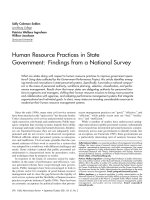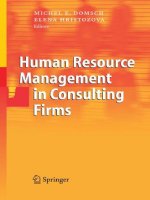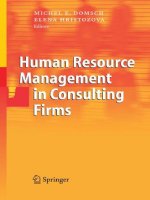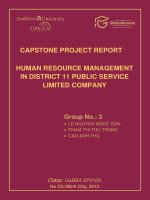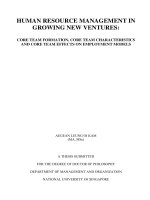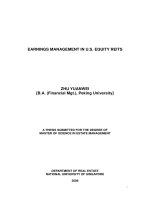Strategic human resource management in u s luxury resorts a case study
Bạn đang xem bản rút gọn của tài liệu. Xem và tải ngay bản đầy đủ của tài liệu tại đây (229.64 KB, 15 trang )
Journal of Human Resources in Hospitality & Tourism
ISSN: 1533-2845 (Print) 1533-2853 (Online) Journal homepage: />
Strategic Human Resource Management in U.S.
Luxury Resorts—A Case Study
Marcia Taylor & Dori Finley
To cite this article: Marcia Taylor & Dori Finley (2008) Strategic Human Resource Management
in U.S. Luxury Resorts—A Case Study, Journal of Human Resources in Hospitality & Tourism,
8:1, 82-95, DOI: 10.1080/15332840802274460
To link to this article: />
Published online: 02 Jan 2009.
Submit your article to this journal
Article views: 3548
View related articles
Citing articles: 11 View citing articles
Full Terms & Conditions of access and use can be found at
/>Download by: [42.113.87.45]
Date: 11 November 2016, At: 00:30
Journal of Human Resources in Hospitality & Tourism, 8:82–95, 2009
Copyright © Taylor & Francis Group, LLC
ISSN: 1533-2845 print / 1533-2853 online
DOI: 10.1080/15332840802274460
Strategic Human Resource Management
in U.S. Luxury Resorts—A Case Study
MARCIA TAYLOR and DORI FINLEY
Department of Hospitality Management, East Carolina University, Greenville, NC
A labor shortage has been experienced in the hospitality industry
and is predicted to continue into the future with a greater impact on
luxury resorts. Resort managers typically look to human resource
(HR) directors to develop strategies to solve this problem. The coalignment model can give managers a competitive advantage in
the marketplace. This study presents the results of a case study
of five luxury resorts in North Carolina. HR directors identified
forces driving change in the environment, strategy choices, firm
structure, and outcomes reflected in firm performance. There was
little evidence that co-alignment was being used as a basis for
planning.
KEYWORDS Strategic management, co-alignment, human resources, resorts
INTRODUCTION
The labor shortage has been recognized nationally as a major force driving
change for decades and is predicted to continue into the future with the
shortage having greater impact on the hospitality industry (Terry, 2005).
This shortage is even more amplified for resorts that are typically located
in remote areas with a high cost of living, low unemployment rates, and a
seasonal need for employees (Angelo & Vladimir, 2004). These three factors
have led to increased turnover and higher overall costs for resorts. In the
past 3 years, there have been many media reports on the seriousness of the
Address correspondence to Marcia Taylor, PhD, Department of Hospitality Management at East Carolina University, RW 312 Rivers, Greenville, NC 27858–4353. E-mail:
82
Strategic Human Resource Management
83
labor shortage in seasonal resorts due to changes in immigration laws (Berta,
2004; Hedlund, 2004).
Solving the labor shortage problem is the responsibility of the human
resources (HR) department. Traditionally, this department has served as support for operations and was viewed as a funnel to provide workers. Administrative functions of the department were viewed as the only contribution
of HR to the total organization. This view changed due to a movement in
business and industry that treated HR as human capital. Today, in some
companies, the HR department has been viewed as a source of competitive
advantage and has become a strategic partner at the executive level (Kearns,
2004). This has served to differentiate companies with a strategic HR emphasis from those without. According to Cooper (2005), what differentiates great
companies from their peers is the ability to hire, develop, and retain the best
people. The effect of a strategic emphasis in hospitality HR departments has
not been documented in the United States, thus the need for research in this
area.
This article reports the results of a case study of five luxury resorts in
North Carolina. The issues investigated in this article include:
(1) recognition by luxury resort HR managers of the forces driving change
in the environment;
(2) competitive methods being utilized to solve the labor shortage;
(3) resources allocated to these competitive methods;
(4) alignment of the three elements of the model with firm performance.
REVIEW OF THE LITERATURE
Beginning with a review of literature on the labor shortage issue, changes in
HR, and the co-alignment model, this study reports results using the elements
of the co-alignment model, and identifies solutions and strategies used by
HR directors in luxury resorts. The hotel industry has been segmented by
Smith Travel Research. The top three categories are luxury, upper upscale,
and upscale (O’Neill, 2006). However, luxury has been redefined as an
experience versus a product (Schiller, 2006). This definition was repeated by
Weinstein (2002) who defined luxury as employees who deliver service that
anticipates needs and who pay attention to guests.
Labor Shortage in Hospitality Management
An evaporating pool of workers, coupled with other labor concerns, may be
the biggest challenge that the hospitality industry faces. The labor force is
expected to grow as little as 16% over the next 20 years, compared with the
50% growth of the previous two decades (Gillette, 1996). The Employment
84
M. Taylor and D. Finley
Policy Foundation forecasts a deficit of labor needed versus labor available
of 10 million workers in 2015 growing to 35 million by 2030 (Holt, 2006).
The National Restaurant Association predicts that the industry will need to
fill 1.4 million new jobs by 2010—more jobs than people willing to take
them (Berta, 2002). The International Society of Hospitality Consultants has
identified a shortage of labor and skills as the number-one issue for 2007
(ISHC, 2006).
Traditionally, seasonal resorts in the United States depended heavily
on workers from other countries for restaurants, housekeeping, and landscaping positions (Taylor, Finley, & Calvert, 2005). Even when there were
plenty of potential employees available, turnover has been a problem in
the industry, hovering at 100% for line workers. The labor shortage in the
hospitality industry has been recognized as a major force driving change
for decades; however, the industry has failed to identify solutions to address this issue. Solutions that could be implemented to ease the shortage
of labor in the industry include outsourcing, improving productivity, recruiting in target markets, developing attractive employment policies, marketing as employer of choice, and increasing skills of employees (Holt,
2006).
According to Ettedgui (2006), the best luxury hotels are known for providing exceptional services and for the sincerity of the people who deliver
those services. This is true in luxury resorts where the delivery of quality
service is usually the number-one priority. In a model of impediments to
improvements in service quality in luxury hotels, Presbury, Fitzgerald, and
Chapman (2005) identified four broad categories of impediments: (1) budget
constraints, (2) staff attitude, (3) lack of mentoring, and (4) high customer expectations. Two of these categories, staff attitude and lack of mentoring, are
impacted by HR policies and procedures. The authors indicate that a lack of
leadership, inexperienced managers, high turnover, recruitment procedures,
and a lack of service ethic in the organization are issues that contribute to the
lack of mentoring and staff attitude. All of these issues impact labor turnover
and should be addressed by hospitality HR directors.
Strategic Management in HR
Historically, the role of HR in a hospitality management company has been
administrative in nature. Fulford and Enz (1995) documented this administrative definition, which they called personnel administration, in the HR
department of a multi-unit restaurant chain. A national trend in HR is to
move from the administrative role to the incorporation of HR in strategic
planning. This movement was aided by the development of the concept
of human capital or human assets in an organization. Human capital is defined as including “skills, judgment, and intelligence of the firm’s employees”
Strategic Human Resource Management
85
(Barney & Wright, 1998, p. 32). In a Norwegian hotel chain, Engstrom, Westnes, and Westnes (2003) identified human capital as one of three components of intellectual capital; the other components were customer capital
and structural capital. These authors identified measures for human capital
as competence, improvement systems, intellectual agility, performance, and
attitude and motivation.
One study that investigated human capital in U.S. hotels identified a Hospitality Human Capital Process Model (Young, McManus, & Canale, 2005).
The three components of the model are (1) service-oriented employees, (2)
empowered employees, and (3) committed employees. Developing serviceoriented employees requires training on guest expectations, an appropriate
hiring process, and a service-oriented culture. Developing empowered employees requires training on problem solving; shared values, norms, and
goals; in addition to an appropriate hiring process and service oriented culture. Managerial activities that develop committed employees include nurturing psychological bonds, treating employees fairly, meeting employee
expectations, in addition to a hiring process that selects “best fit” employees.
This model delineates a comprehensive program for maximizing hospitality
HR.
Building on the view of HR as human capital, strategic human resources management (SHRM) includes approaches for matching people
to business strategies (Miles & Snow, 1984). A model of development of
the HR function in organizations includes five levels divided into two categories according to Kearns (2004). The two categories are where employees are seen as a cost/resource and where employees are seen as a
competitive advantage. When employees are seen as a competitive advantage, HR becomes a strategic partner responsible for getting the maximum
value from the company employees. Strategic HR managers see the workforce as a source of strategic advantage, not a cost to minimize (Pfeffer,
2005).
An increase in the strategic approach to human resources management
in the U.K. hotel industry was reported by Hoque (1999) and was recommended for multi-unit restaurants by Fulford and Enz (1995). It was proposed
by Guest (1987) that the integration of HR into strategic plans supported
by policies, a culture that stresses the importance of HR, and employee
commitment will lead to the successful implementation of those strategic
plans.
The results of a project to investigate the impact of technical (the administrative role) HR and SHRM on firm performance indicated that SHRM
has more positive impact on firm performance than technical HR (Huselid,
Jackson, & Schuler, 1997). These researchers also linked SHRM to competitive advantage and, in turn, to business performance. Olsen, West, and Tse
(2007) use the co-alignment model to demonstrate the significance of this
link.
86
M. Taylor and D. Finley
FIGURE 1 Co-alignment Model Adapted from Olsen et al. (2007)
Co-Alignment Model
As early as 1983, strategic management has been recognized as important for managers in the hospitality industry (Reichel, 1983). More recently Kim and Oh (2004) recommended the use of a comprehensive,
integrated strategic-management method to give hotels a competitive advantage. The co-alignment principle is a strategic-management theory that
implies that companies can gain a sustainable competitive advantage if
management adopts the principles of the theory in their everyday operations (Olsen et al., 2007). In support of this theory, Olsen et al. (2007)
developed a model that consists of four constructs necessary in achieving co-alignment within business. According to the co-alignment principle model, if management can (1) identify opportunities that exist in the
forces driving change in the environment, (2) invest in competitive methods (strategy choices) that take advantage of these opportunities, and (3)
allocate resources to those methods that create the greatest value, then they
can (4) achieve sustainable competitive advantage (Olsen et al., 2007; see
Figure 1).
A firm’s success depends on the management’s awareness of the environment and ability to identify and adapt to changes. According to Olsen
et al. (2007), the co-alignment model is similar to other strategic management concepts, but it is future oriented. The application of the co-alignment
model to the hospitality industry has been reported by Olsen et al. (2007)
and in many unpublished dissertations. Typically, the hotel industry is considered a “copycat industry.” Hoteliers are quick to copy innovations by
others. Adopting the co-alignment model can give a resort manager a competitive advantage in the marketplace. Due to the competition for luxury
travelers and the short lifespan of luxury services, application of this model
is appropriate for managers in luxury resorts.
PURPOSE OF STUDY
The purpose of this study was to answer two research questions: (1) Are
luxury resorts investing in competitive methods to take advantage of the
Strategic Human Resource Management
87
opportunities that exist in the forces driving change in the environment? (2)
Are luxury resorts allocating resources to those competitive methods that
create the greatest value? Specifically, the study sought to find out if luxury
resort HR managers recognize the forces driving change in the environment,
the competitive methods they are utilizing to solve the labor shortage, how
they are allocating resources to these competitive methods, and the performance indicators as a result of implementation.
METHODOLOGY
To answer the research questions, the case study method with multiple
cases as described by Yin (1993) was used. The case study method has been
demonstrated as appropriate in testing the co-alignment model because researchers must enter into the domain of the firm and study it in depth in
order to understand the complexities of the situation (Taylor & Olsen, 2006).
The use of face-to-face interviews has proved effective in testing the coalignment model because the subjects may not be familiar with the concepts
included in the co-alignment model, and interviewing allows researchers to
probe and use questions to get a valid response. Other researchers (mostly
unpublished dissertations) have used the case study method in investigating the co-alignment model. In addition, Aung (2000) used the case study
method to identify the core competencies of the Accor hotel chain.
The focus for this study was 4-star resorts in North Carolina. Seven
resorts were identified in the Official 2005 North Carolina Travel Guide
(2005). After contacting the HR directors at these resorts, five of the seven
HR directors agreed to participate in the study. Yin (1993) suggested the
use of multiple cases be viewed as multiple experiments and not multiple
respondents to a survey. The consensus for numbers of cases falls between
two and four as the minimum and ten and fifteen as the maximum (Perry,
1998). Therefore, the five cases were considered to be adequate for this case
study.
A structured questionnaire consisting of twenty-seven open-ended questions was developed to serve as the basis of the face-to-face interviews with
each director on location at the resort. Six of the questions were descriptive
of the resort. Five questions sought to identify the forces in the environment
identified by the HR director as driving change in the hotel industry. These
forces also have the potential of affecting the resort in the future and are
contributing to problems in HR at the resort. Four questions addressed the
strategy choices or competitive methods utilized by the resorts. Specifically,
the HR directors were asked to identify the resort’s competitive methods and
what was included in each method. They were also asked how competitive methods were chosen and which methods were perceived as adding
the most value to the resort. The next five questions sought to identify how
88
M. Taylor and D. Finley
capital and HR were allocated to the competitive methods. Firm performance
in terms of financial performance was identified in the final eight questions.
The questionnaire was e-mailed to the HR director for preparation prior
to the face-to-face interview. The interviews ranged from 1.5 to 2.5 hours
in length. In addition to the interview, the researchers were able to observe
the implemented strategies at each property to confirm information received
during the interviews. Interviews were transcribed and content analysis was
used to evaluate the responses (Neuendorf, 2002).
RESULTS AND DISCUSSION
The results of the case study include demographic information about the
resorts, content analysis for components of the co-alignment model, and
evaluation of the alignment/nonalignment of the components.
Characteristics of the Sample
There was a wide cross-section of locations for the resorts ranging from
mountain to ocean and from city to countryside. All had convention and
meeting spaces, all but one had spas, and all but one had golf courses.
Three resorts were medium-sized hotels with under 300 rooms. One resort
had more than 500 rooms. The resorts were not chain owned or operated.
Two of the resorts would be considered historical properties; however, all
of the resorts are recognized as luxury resorts in North Carolina. Only one
of the resorts operated as a seasonal resort.
Forces in the Environment Driving Change
The first component of the co-alignment model is the identification of forces
in the environment that are driving change. All HR directors identified similar environmental forces driving change in their resorts (see Table 1). All
directors cited economic issues related to labor and guests as forces driving change in the environment. The labor issues included immigration and
diversity of the workforce, unemployment rates, energy costs (gasoline) for
employees, changes in benefits and their increasing costs, and the generational mix. Economic issues related to guests included growth in family travel
and more choices of resorts as a result of new competition. Other issues that
were identified included the impact of technology and environmental concerns.
Application of the co-alignment model to the five cases indicated that
the HR directors were monitoring forces in the environment. However, there
was a range of focus used by the directors. All but one of the HR directors was
Strategic Human Resource Management
89
focusing on the environment at the national and international level, which
contrasted with the other director who was focused locally. As suggested by
Schuler and Jackson (2005), looking more broadly will assist HR directors
in becoming strategic partners in operations decisions. Three of the HR
directors had participated in an executive-level strategic-planning process
that identified forces in the environment that were impacting their resorts.
While at the other end of the continuum, the HR directors monitored local
events.
Strategy Choices/Competitive Methods
The second component of the co-alignment model is the utilization of strategy choices/competitive methods. The HR directors identified their strategy
choices/competitive methods for two of the labor issues and both of the
guests’ issues. No strategy choices/competitive methods were identified for
the technology and environmental issues (see Table 1). Strategies selected to
address the unemployment rate issue included use of H2B and H-1 visa employees (guest workers or temporary workers), offering competitive benefits
and salaries, leadership development and increased training, developing a
company culture and loyalty among employees, offering incentive programs,
redefining full-time employment, and extending the seasons with off-season
offerings. Strategies utilized to address the increased cost and changing nature of benefits included redefining full-time employment, flextime, child
care, and job sharing. No strategies were implemented to address the HRrelated issues of immigration and diversity of the workforce, energy costs for
employees, or the generational mix.
The growth in family travel was addressed by renovated facilities, added
amenities, increased service quality, and package pricing. New competition
resulted in renovated facilities, added amenities, increased service quality,
package pricing, leadership development, and increased training and cobranding. The strategies identified for the two changes in guest needs were
the same with new competition generating the need for leadership development, increased training, and co-branding.
It can be concluded from these findings that HR directors are making
strategic choices or developing competitive methods to address the forces
driving change in the environment. Six methods were developed to address
more than one force in the environment, which is similar to the results in
other studies (Young et al., 2005). The range in strategy choices varied from
comprehensive to piecemeal. Three of the HR directors described “People
Strategies,” which were very comprehensive programs, while others listed
separate competitive methods with no linkage. The range of the methods was
from those based on data analysis, as in the total rewards strategy described
by Fischer, Gross, and Friedman (2003), to others based on “best guess.”
90
M. Taylor and D. Finley
TABLE 1 Content Analysis Results for Forces in the Environment, Strategy
Choices/Competitive Methods, and Firm Structure
Forces in the
Environment
Strategy Choices/
Competitive Methods
Economic Issues—Labor
Unemployment rates
H2B, J-1 Visas
Competitive benefits and
salaries
Benefits increasing in
cost and changing in
nature
Leadership development
and increased training
Developing a company
culture
Building loyalty among
employees
Incentive programs
Redefining full-time
employment
Extending seasons
Redefining full-time
employment
Firm Structure
Increased HR
budgets
Changing
management
structure to
compliment capital
investment
HR as strategic
partner
Culture committee
Flextime
Child care
Job sharing
Immigration and
diversity of the work
force
Energy costs for
employees
Generational mix
Economic Issues—Guests
Growth in family
travel due to
increasing energy
costs or value of time
New competition
Other Issues
Technology
Environmental
Renovated facilities
Added amenities
Increased service quality
Package pricing
Renovated facilities
Added amenities
Increased service quality
Package pricing
Leadership development
and increased training
Cobranding
Focused marketing
Focused marketing
Strategic Human Resource Management
91
For example, in one resort, for every dollar invested in their employees
an increase of three dollars in profit was generated. At another resort, any
increase in revenue was interpreted as meaning that they were doing the
right thing.
Competitive strategies that impacted employees directly included redefining full-time work, offering competitive wages and benefits, creating
loyalty in employees, and a variety of changes to encourage a more-stable
workforce. In one resort, the minimum number of hours required for an employee to receive full-time benefits was decreased from 40 hours per week
to 30 hours per week. This change allowed employees to stay on the payroll
and receive benefits during slower seasons. A variety of wellness programs
and incentive programs were described as methods for increasing the health
and well-being of employees and to reward employees for contributing to
the bottom line of the resort.
The HR director at one resort reported treating employees like family as a method used to create loyalty in the workforce. Examples of how
a family environment type of work culture was created included fundraisers, company support for employees with need, supporting the community
with funds, and paid time for employees to assist community organizations.
Changes made to encourage a more stable workforce included extending
the seasons by offering themed weekend events, promoting job sharing,
and offering flextime. It is interesting to note that none of the resorts used
outsourcing to solve labor problems and the implementation of all of these
changes decreased the need to use guest workers.
Competitive HR strategies that were implemented in response to the
changes in guest needs included more training and leadership development,
and developing a full-time, year-round workforce. The increase in training
allowed the resorts to capitalize on the strengths of their current employees.
By decreasing the need for part-time or seasonal workers, the resorts could
offer consistent quality service as demanded by guests at a luxury resort.
Firm Structure
The third component of the co-alignment model is the firm structure required to implement the strategy choices/competitive methods that have
been selected. Results in Table 1 indicate increased HR budgets, change of
management structure to compliment capital investment, involving HR as
a strategic partner, and establishing a culture committee as needed to address the unemployment rate issue. Focused marketing was implemented to
address both of the guest issues.
Structural changes that were identified by the HR directors were not
as comprehensive as the strategy choices. In addition, they were not tied
directly to a strategy choice as the co-alignment model would indicate. The
comprehensiveness of the responses received from the HR directors ranged
92
M. Taylor and D. Finley
from all of the structural changes included in Table 1 to listing only one—
increased HR budgets.
Firm Performance
The final component of the co-alignment model is the firm performance
measures that are used to determine the impact of the changes. Traditional
measures of performance in the lodging industry (average daily rate [ADR],
revenue per available Room [RevPar], turnover, etc.) were identified by all
but two of the HR directors. These results are similar to those reported
by Mandelbaum (2006). It was interesting to note that almost all of the
respondents did not have access to the operating data on a regular basis
and in no case could alignment be determined. The annual ADR ranged
from $185 to $300, annual occupancy rates ranged from 59% to 96%, and
annual RevPar ranged from $125 to $559. Only one HR director reported
seasonal data. Employee data included payroll percentages ranging from
32% to 38.5%, employees to rooms ranging from 1.1 to 1.9, and turnover
percentages ranging from 16.5% to 65%.
The wide range in RevPar, occupancy rates and turnover were due to
data from one seasonal resort. Turnover rates were also impacted by the
use of temporary guest workers. The HR directors reported that turnover
rates were not increasing. This trend is different from a study by the Society
for Human Resource Management where 38% of the members reported increasing turnover rates (Feeney, 2007). While it is difficult to link these data
as outcomes for a strategy choice and change in firm structure, there was
a trend for lower turnover rates in the resorts with a more comprehensive
“People Strategy.”
IMPLICATIONS AND CONCLUSION
Succeeding in the resort industry requires alignment between the four elements of the co-alignment model: (1) the environment, (2) strategy choice(s),
and (3) firm structure, which leads to an outcome reflected in the (4) firm
performance (Olsen et al., 2007). From the interviews with the HR directors,
it was clear that the forces driving change in the hospitality industry environment, and more specifically the resort industry, were identified as economic
issues related to labor and guests. Each of the HR directors identified forces
in the environment; however, the critical difference was in looking locally
versus nationally for changes. In two of the five resorts, the HR director was
viewed as a source for strategies to address the changes in the environment.
In the other three resorts, the HR director was not. In all but one of the
resorts creative structural changes are being made to achieve competitive
advantage.
Strategic Human Resource Management
93
When applying the co-alignment model in this case study, there is very
little evidence that co-alignment is being used as a basis for planning. The
forces driving change in the environment and competitive methods were
identified by all HR directors. The allocation of resources to these methods
was not clearly delineated. In addition, the outcome measures and the effectiveness of each method were not identified by the directors. Use of the
co-alignment model could give these resorts a competitive advantage due to
their constant need for outstanding service as expected in a luxury resort.
Although limited to resorts in only one southeastern U.S. state, the findings indicate the need to duplicate this research project with data gathered
from more resorts across the country. Through additional case studies, the
use of SHRM and the co-alignment model could be documented as providing
a competitive advantage in resorts. Further research needs to be conducted
using the general manager as the source for information. The results of such a
study would be strengthened by their knowledge of performance measures.
Despite the limited number of cases in this study, the information gathered should help HR directors in the hotel industry as they identify and react
to the forces driving change in the environment.
REFERENCES
Angelo, R., & Vladimir, A. (2004). Hospitality today: An introduction. Lansing, MI:
Educational Institute of the American Hotel and Lodging Association.
Aung, M. (2000). The Accor multinational hotel chain in an emerging market:
Through the lens of the core competency concept. Service Industries Journal,
20(3), 43–60.
Barney, J. B., & Wright, P. M. (1998). On becoming a strategic partner: The role of
human resources in gaining competitive advantage. Human Resource Management, 37(1), 31–46.
Berta, D. (2002). Special report—opportunity through tears: Immigration. Nation’s
Restaurant News, 36, 9, 122–123.
Berta, D. (2004). U.S. to foreign workers: Stay home for the summer. Nation’s Restaurant News, 38, 1–3, 15.
Cooper, K. (2005). The missing link in people strategies. Customer Inter@ction Solutions, 24, 5, 48–50.
Engstrom, T. E. J., Westnes, P., & Westnes, S. F. (2003). Evaluating intellectual capital
in the hotel industry. Journal of Intellectual Capital, 4(3): 287–303.
Ettedgui, E. (2006, September 18). Striving to offer quality in a flawless manner.
Financial Times, 5.
Feeney, P. (2007). Hotel recruitment: Is a talent shortage looming? Hotelexecutive.com. Retrieved January 4, 2007 from, http//www.hotelexecutive.com/
bus rev/pub/002/744.asp
Fisher, K., Gross, S. E., & Friedman, H. M. (2003). Marriott makes the business case
for an innovative total rewards strategy. Journal of Organizational Excellence,
22(2), 19.
94
M. Taylor and D. Finley
Fulford, M. D., & Enz, C. A. (1995). Human resources as a strategic partner in
multiunit-restaurants. Cornell Hotel and Restaurant Administration Quarterly,
36(3), 24–29.
Gillette, B. (1996). Labor pains (labor shortage in the hospitality industry). Hotel and
Motel Management, 211(4), 24–26.
Guest, D. E. (1987). Human resource management and industrial relations. Journal
of Management Studies, 24(5), 503–521.
Hedlund, S. (2004). Restaurateurs and processors brace for a potential labor shortage:
Employers urge lawmakers to lift or raise the annual cap on foreign seasonal
workers. Seafood Business, 23(5), 34.
Holt, K. (2006). Workforce plan critical to survival during labor deficit. Hotel and
Motel Management, 221(16), 27.
Hoque, K. (1999). New approaches to HRM in the UK hotel industry. Human Resource Management Journal, 9(2), 64–76.
Huselid, M. S., Jackson, S. E., & Schuler, R. S. (1997). Technical and strategic human resource management effectiveness as determinants of firm performance.
Academy of Management Journal, 40(1), 171–188.
ISHC. (2006, November 20). Top ten issues in the hospitality industry for 2007.
Hospitality Net. Retrieved December 1, 2006, from pitalitynet.
org/news/ 4029554/print
Kearns, P. (2004). How strategic are you? The six “killer” questions. Strategic HR
Review, 3(3), 20–23.
Kim, B. Y., & Oh, H. (2004). How do hotel firms obtain a competitive advantage?
International Journal of Contemporary Hospitality Management, 16(1), 65–71.
Mandelbaum, R. (2006, June 26). Resort hotels—Wanted: Eaters, golfers, and
shoppers. Hotel Interactive. Retrieved June 26, 2006, from http://www.
hotelinteractive.com/hi articles.asp?func-print&article id=6002
Miles, R. E., & Snow, C. C. (1978). Organizational strategy, structure and process.
New York: McGraw-Hill.
Neuendorf, K. A. (2002). The content analysis guidebook. Thousand Oaks, CA: Sage.
Official 2005 North Carolina travel guide. (2005). Raleigh, NC: State of North Carolina
Department of Commerce, Division of Tourism, Film, and Sports Development.
Olsen, M., West, J., & Tse, E. (2007). Strategic management in the hospitality industry
(3rd Ed.). New York: Prentice Hall.
O’Neill, J. W. (2006). Defining segments. Lodging Hospitality. Retrieved September
10, 2006, from />Pfeffer, J. (2005). Producing sustainable competitive advantage through the effective
management of people. Academy of Management Executive, 19(4), 95–106.
Perry, C. (1998). Processes of a case study methodology for postgraduate research
in marketing. European Journal of Marketing, 32(9/10), 785–802.
Presbury. R., Fitzgerald, A., & Chapman, R. (2005). Impediments to improvements
in service quality in luxury hotels. Managing Service Quality, 15, 4, 357–373.
Reichel, A. (1983). Strategic management: How to apply it to firms in the hospitality
industry. Service Industries Journal, 3(3), 329–343.
Schiller, P. (2006). The new luxury. Retrieved January 5, 2005, from http://www.
diamonds.net/news/NewsItem.aspx?ArticleID=11089
Strategic Human Resource Management
95
Schuler, R. S., & Jackson, S. E. (2005). A quarter-century review of human resource
management in the U.S.: The growth in importance of the international perspective. Management Review, 16(1), 11–35.
Taylor, M., Finley, D., & Calvert, C. (2005, October) Use of guest workers in seasonal
resorts: A pilot study. Proceedings of International Hospitality and Tourism
Conference, 12–15.
Taylor, M., & Olsen, M. D. (2006). Measuring co-alignment in hotels. Unpublished
paper.
Terry, J. W. (2005). Cause for concern: Lodging HR. American Hotel and Lodging
Association, 6(11).
Weinstein, J. (2002). Editor’s diary. Defining luxury. Hotels. Retrieved September 10,
2006, from />Yin, R. K. (1993). Applications of case study research. Newbury Park, CA: Sage.
Young, C., McManus, A., & Canale, D. (2005). A value-driven process model of hospitality human capital. Journal of Human Resources in Hospitality and Tourism,
4(2), 1–26.

